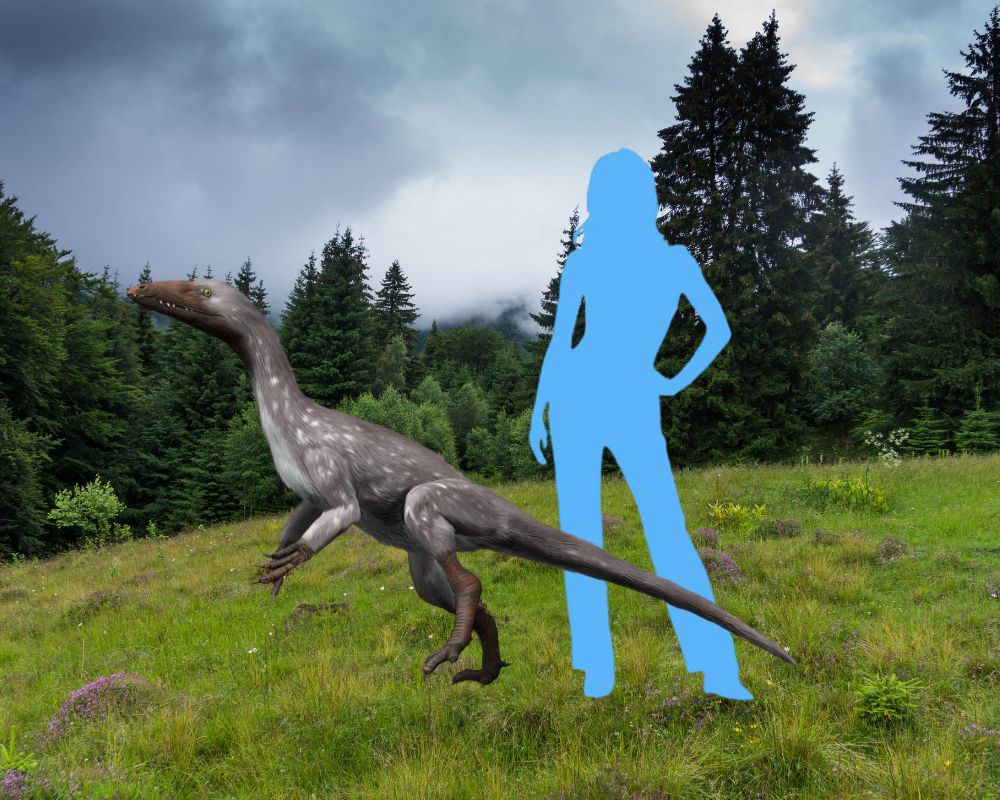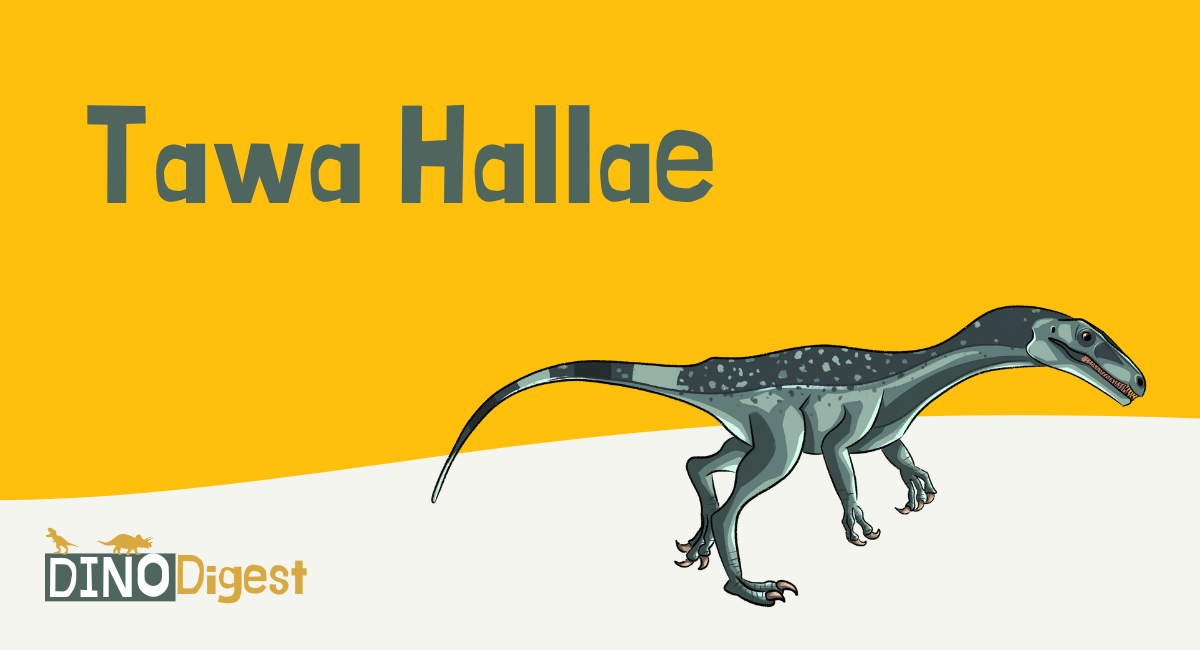We didn’t know much about the first dinosaurs in the Triassic period long ago. However, discovering almost complete fossil remains of the Tawa Hallae in 2004 changed everything we knew about early dinosaurs. The Tawa Hallae were small, fast, and agile creatures that paved the way for the dinosaurs of the Jurassic and Cretaceous periods.
Table of Contents
Some Quick Facts about the Tawa Hallae

| Name | Tawa Hallae ( Tawa = Sun God, Hallae = Ruth Hall) |
| Type of dinosaur | Theropod |
| Territory | Warm, grassy areas, New Mexico |
| Size | 8 feet long, |
| Color | Dark body |
| Interesting Characteristics | Small arms, razor-sharp teeth, hollow bones |
| Diet | Smaller dinosaurs |
| Major Threats | Bigger dinosaurs, natural disasters |
In 2004, paleontologists uncovered a new dinosaur called the Tawa Hallae that changed what we knew about the first dinosaurs. It was one of the first meat-eating dinosaurs to roam planet Earth and a fierce predator. While it was much smaller than later theropod dinosaurs, its lightweight frame, powerful arms, and razor-sharp teeth helped it thrive in the early years of the dinos.
Why Is the Tawa Hallae Important?
Up until recently, we didn’t know much about the dinosaurs in the early Triassic period. And the Tawa Hallae changed all that.
Learning about prehistoric creatures that lived almost 250 million years ago is like putting together a complicated puzzle. Paleontologists have fossilized fragments they use to learn more about these creatures, but they don’t tell the whole story.
Even today, paleontologists find new pieces to this 250 million-year-old puzzle. And the discovery of Tawa Hallae was a critical piece of that puzzle. The recent discovery of Tawa Hallae tells us more about the first meat-eating dinosaurs that roamed planet earth, which is why this discovery is so important.
What Type of Dinosaur Was a Tawa Hallae?
Tawa Hallae was one of the first Triassic dinosaurs, along with the Coelophysis, Eoraptor, and Herrerasaurus. These three dinosaurs lived around the same time during the late Triassic period and paved the way for more ferocious dinos in the Jurassic and Cretaceous periods.
This theropod dinosaur shares much in common with famous dinos like the Tyrannosaurus rex, Velociraptors, and other carnivorous dinosaurs. The Tawa Hallae is a step in the early evolution of dinosaurs.
As a meat eater, it dined on smaller creatures like lizards and used its sharp teeth and strong claws to hunt. Its hollow bones and solid back legs made it super fast. If you were a small lizard in the Triassic period, you did not want to be in its sight!
What Is the Significance of the Name Tawa Hallae?
The name Tawa Hallae doesn’t sound like your average dino name. The name is broken down into two parts, ‘Tawa’ and ‘Hallae.’
First, let’s look at the term Tawa. Tawa is a Hopi term for the Puebloan sun god. The Puebloans were Native Americans living in the Southwestern portion of the United States, right around where Tawa Hallae were discovered. The term Tawa pays tribute to the native people of the land where this dino lived.
Next, the word Hallae is named after the paleontologist Ruth Hall who collected fossil remains at Ghost Ranch. Ruth Hall is not only the person that helped unearth this prehistoric dinosaur, but she is also the founder of the Ghost Ranch Museum of Paleontology.
Where Was Tawa Hallae Discovered?
The fossil remains of the Tawa Hallae were first discovered in 2004 at the Ghost Ranch in New Mexico. The Ghost Ranch was a dinosaur graveyard where hundreds of dinosaur bones were unearthed. Many paleontologists believe that a flash flood caused so many dinos to die in a single area.
What’s impressive about the Hayden Quarry Ghost Ranch is that nearly complete fossil remains of the Tawa Hallae were pieced together. The graveyard helped paleontologists learn a lot about this primitive carnivore.
Ruth Hall’s research at Ghost Ranch gave paleontology a complete skeleton of a Late Triassic saurischian, which helped everyone understand the early evolution of dinosaurs.
Where Did the Tawa Hallae Live?
Earth looked very different 250 million years ago when Tawa Hallae walked the Earth. During the Triassic period, the Earth wasn’t divided into continents. Instead, it was a giant continent called Pangea. As the Earth shifted in the next 200 million years, the bones of Tawa Hallae scattered throughout the continents.
Paleontologists believe that Tawa Hallae lived in warm, wet areas with plenty of food. They lived in areas ranging from South America to parts of North America. As Earth moved and shifted, the dispersal of bones shifted from continents.
Was a Tawa Hallae More Bird or Lizard?

Some dinosaurs have lizard-like features, and they are called saurischians. Dinos with bird-like features are called ornithischians. So was the Tawa Hallae more like a bird or a lizard? The answer is a little of both!
Paleontologists believe that the Tawa Hallae had feathers similar to that of a bird. As a theropod, the Tawa Hallae had hollow bones, much like modern-day birds. These hollow bones with air sacs allowed them to stay quick on their feet to catch prey.
However, the Tawa Hallae had the hip structure of a lizard. Dinosaurs with hips that face forward are called saurischians. It makes things a little confusing. Overall, the Tawa Hallae is a lizard-like dinosaur with the hollow bones and feathers of a bird.
What We Know Is Always Changing
The discovery of Tawa Hallae is pretty recent. It was discovered in 2004 and changed much of what we know about early meat-eating dinosaurs!
Even today, paleontologists are still finding new species of dinosaurs that tell us a little bit more about the bigger picture. The land that we stand on right now holds so many secrets about the life of dinosaurs just waiting to be discovered!

